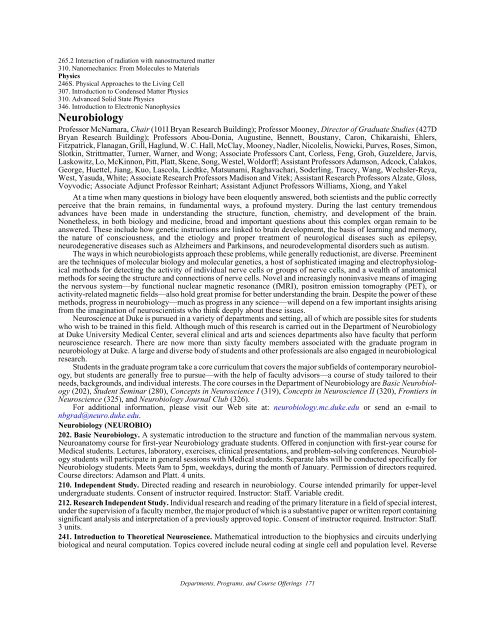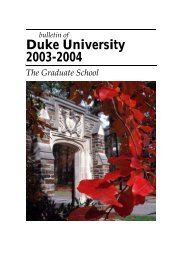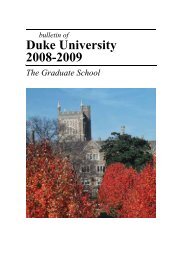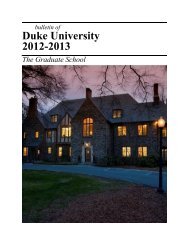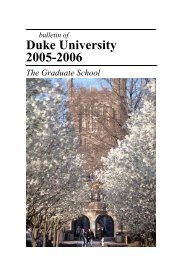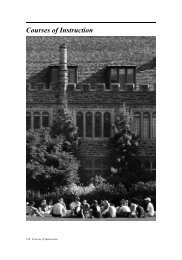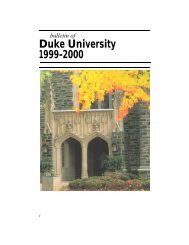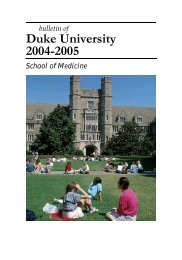Duke University 2009-2010 - Office of the Registrar - Duke University
Duke University 2009-2010 - Office of the Registrar - Duke University
Duke University 2009-2010 - Office of the Registrar - Duke University
You also want an ePaper? Increase the reach of your titles
YUMPU automatically turns print PDFs into web optimized ePapers that Google loves.
265.2 Interaction <strong>of</strong> radiation with nanostructured matter<br />
310. Nanomechanics: From Molecules to Materials<br />
Physics<br />
246S. Physical Approaches to <strong>the</strong> Living Cell<br />
307. Introduction to Condensed Matter Physics<br />
310. Advanced Solid State Physics<br />
346. Introduction to Electronic Nanophysics<br />
Neurobiology<br />
Pr<strong>of</strong>essor McNamara, Chair (101I Bryan Research Building); Pr<strong>of</strong>essor Mooney, Director <strong>of</strong> Graduate Studies (427D<br />
Bryan Research Building); Pr<strong>of</strong>essors Abou-Donia, Augustine, Bennett, Boustany, Caron, Chikaraishi, Ehlers,<br />
Fitzpatrick, Flanagan, Grill, Haglund, W. C. Hall, McClay, Mooney, Nadler, Nicolelis, Nowicki, Purves, Roses, Simon,<br />
Slotkin, Strittmatter, Turner, Warner, and Wong; Associate Pr<strong>of</strong>essors Cant, Corless, Feng, Groh, Guzeldere, Jarvis,<br />
Laskowitz, Lo, McKinnon, Pitt, Platt, Skene, Song, Westel, Woldorff; Assistant Pr<strong>of</strong>essors Adamson, Adcock, Calakos,<br />
George, Huettel, Jiang, Kuo, Lascola, Liedtke, Matsunami, Raghavachari, Soderling, Tracey, Wang, Wechsler-Reya,<br />
West, Yasuda, White; Associate Research Pr<strong>of</strong>essors Madison and Vitek; Assistant Research Pr<strong>of</strong>essors Alzate, Gloss,<br />
Voyvodic; Associate Adjunct Pr<strong>of</strong>essor Reinhart; Assistant Adjunct Pr<strong>of</strong>essors Williams, Xiong, and Yakel<br />
At a time when many questions in biology have been eloquently answered, both scientists and <strong>the</strong> public correctly<br />
perceive that <strong>the</strong> brain remains, in fundamental ways, a pr<strong>of</strong>ound mystery. During <strong>the</strong> last century tremendous<br />
advances have been made in understanding <strong>the</strong> structure, function, chemistry, and development <strong>of</strong> <strong>the</strong> brain.<br />
None<strong>the</strong>less, in both biology and medicine, broad and important questions about this complex organ remain to be<br />
answered. These include how genetic instructions are linked to brain development, <strong>the</strong> basis <strong>of</strong> learning and memory,<br />
<strong>the</strong> nature <strong>of</strong> consciousness, and <strong>the</strong> etiology and proper treatment <strong>of</strong> neurological diseases such as epilepsy,<br />
neurodegenerative diseases such as Alzheimers and Parkinsons, and neurodevelopmental disorders such as autism.<br />
The ways in which neurobiologists approach <strong>the</strong>se problems, while generally reductionist, are diverse. Preeminent<br />
are <strong>the</strong> techniques <strong>of</strong> molecular biology and molecular genetics, a host <strong>of</strong> sophisticated imaging and electrophysiological<br />
methods for detecting <strong>the</strong> activity <strong>of</strong> individual nerve cells or groups <strong>of</strong> nerve cells, and a wealth <strong>of</strong> anatomical<br />
methods for seeing <strong>the</strong> structure and connections <strong>of</strong> nerve cells. Novel and increasingly noninvasive means <strong>of</strong> imaging<br />
<strong>the</strong> nervous system—by functional nuclear magnetic resonance (fMRI), positron emission tomography (PET), or<br />
activity-related magnetic fields—also hold great promise for better understanding <strong>the</strong> brain. Despite <strong>the</strong> power <strong>of</strong> <strong>the</strong>se<br />
methods, progress in neurobiology—much as progress in any science—will depend on a few important insights arising<br />
from <strong>the</strong> imagination <strong>of</strong> neuroscientists who think deeply about <strong>the</strong>se issues.<br />
Neuroscience at <strong>Duke</strong> is pursued in a variety <strong>of</strong> departments and setting, all <strong>of</strong> which are possible sites for students<br />
who wish to be trained in this field. Although much <strong>of</strong> this research is carried out in <strong>the</strong> Department <strong>of</strong> Neurobiology<br />
at <strong>Duke</strong> <strong>University</strong> Medical Center, several clinical and arts and sciences departments also have faculty that perform<br />
neuroscience research. There are now more than sixty faculty members associated with <strong>the</strong> graduate program in<br />
neurobiology at <strong>Duke</strong>. A large and diverse body <strong>of</strong> students and o<strong>the</strong>r pr<strong>of</strong>essionals are also engaged in neurobiological<br />
research.<br />
Students in <strong>the</strong> graduate program take a core curriculum that covers <strong>the</strong> major subfields <strong>of</strong> contemporary neurobiology,<br />
but students are generally free to pursue—with <strong>the</strong> help <strong>of</strong> faculty advisors—a course <strong>of</strong> study tailored to <strong>the</strong>ir<br />
needs, backgrounds, and individual interests. The core courses in <strong>the</strong> Department <strong>of</strong> Neurobiology are Basic Neurobiology<br />
(202), Student Seminar (280), Concepts in Neuroscience I (319), Concepts in Neuroscience II (320), Frontiers in<br />
Neuroscience (325), and Neurobiology Journal Club (326).<br />
For additional information, please visit our Web site at: neurobiology.mc.duke.edu or send an e-mail to<br />
nbgrad@neuro.duke.edu.<br />
Neurobiology (NEUROBIO)<br />
202. Basic Neurobiology. A systematic introduction to <strong>the</strong> structure and function <strong>of</strong> <strong>the</strong> mammalian nervous system.<br />
Neuroanatomy course for first-year Neurobiology graduate students. Offered in conjunction with first-year course for<br />
Medical students. Lectures, laboratory, exercises, clinical presentations, and problem-solving conferences. Neurobiology<br />
students will participate in general sessions with Medical students. Separate labs will be conducted specifically for<br />
Neurobiology students. Meets 9am to 5pm, weekdays, during <strong>the</strong> month <strong>of</strong> January. Permission <strong>of</strong> directors required.<br />
Course directors: Adamson and Platt. 4 units.<br />
210. Independent Study. Directed reading and research in neurobiology. Course intended primarily for upper-level<br />
undergraduate students. Consent <strong>of</strong> instructor required. Instructor: Staff. Variable credit.<br />
212. Research Independent Study. Individual research and reading <strong>of</strong> <strong>the</strong> primary literature in a field <strong>of</strong> special interest,<br />
under <strong>the</strong> supervision <strong>of</strong> a faculty member, <strong>the</strong> major product <strong>of</strong> which is a substantive paper or written report containing<br />
significant analysis and interpretation <strong>of</strong> a previously approved topic. Consent <strong>of</strong> instructor required. Instructor: Staff.<br />
3 units.<br />
241. Introduction to Theoretical Neuroscience. Ma<strong>the</strong>matical introduction to <strong>the</strong> biophysics and circuits underlying<br />
biological and neural computation. Topics covered include neural coding at single cell and population level. Reverse<br />
Departments, Programs, and Course Offerings 171


